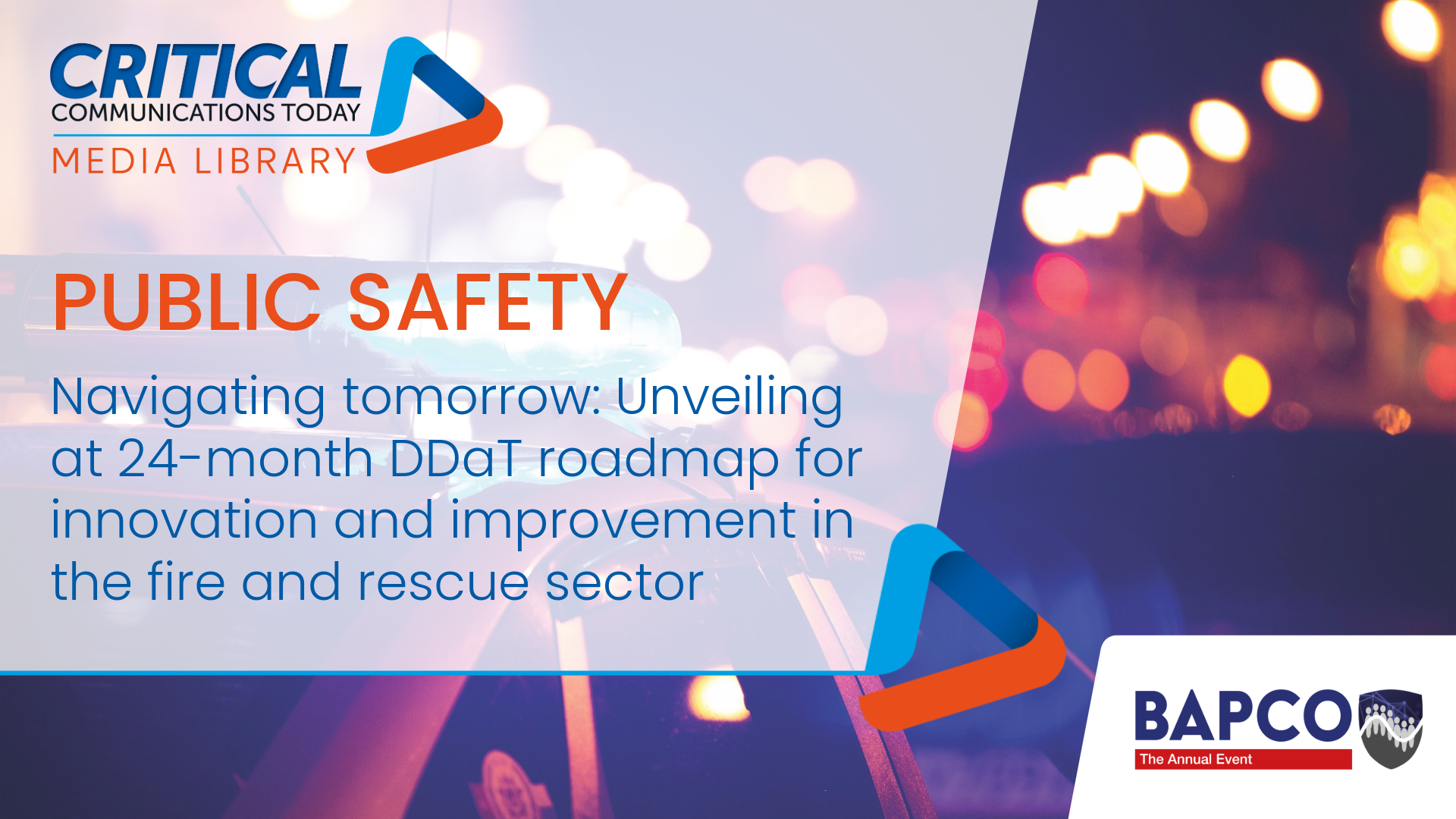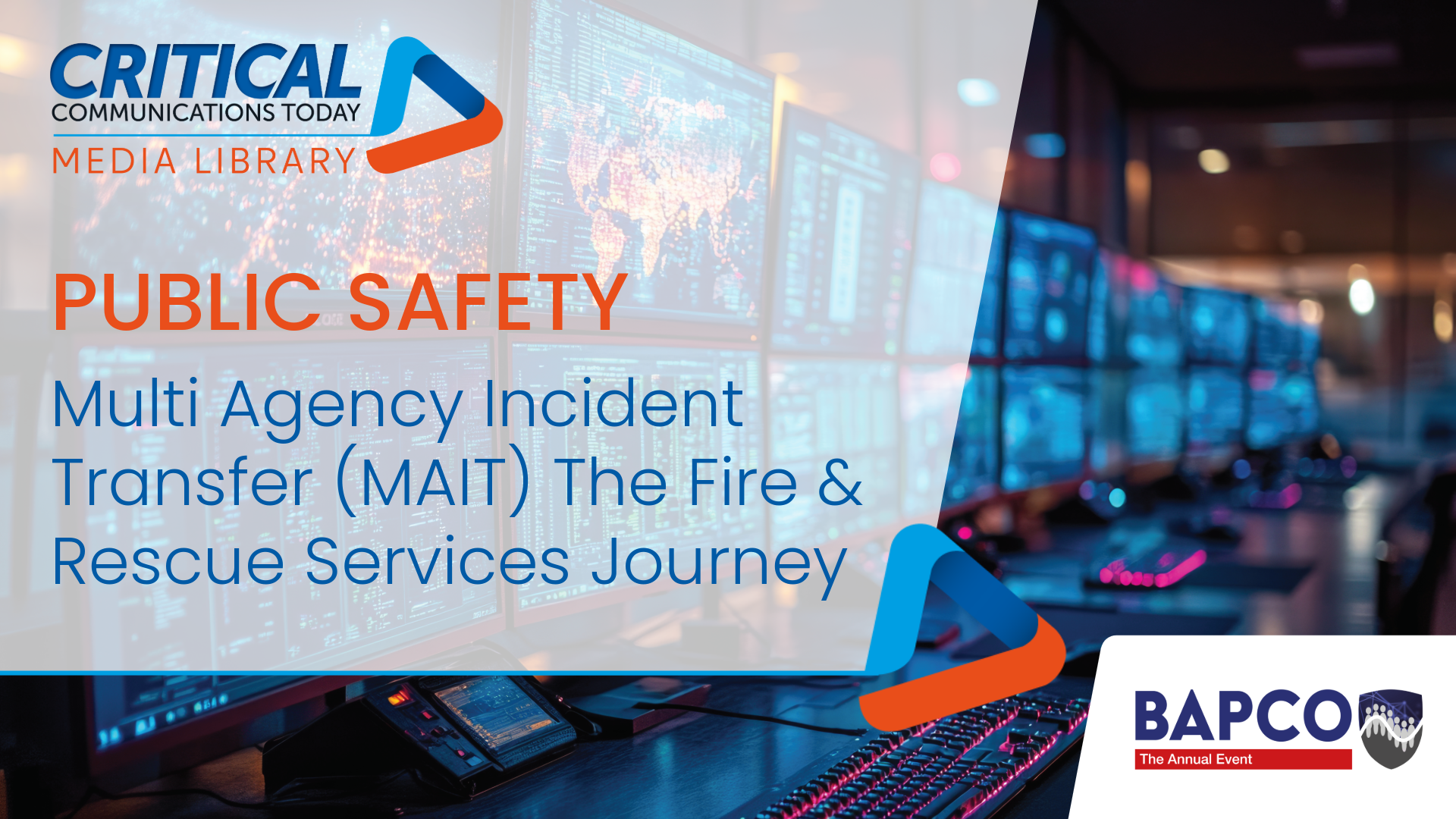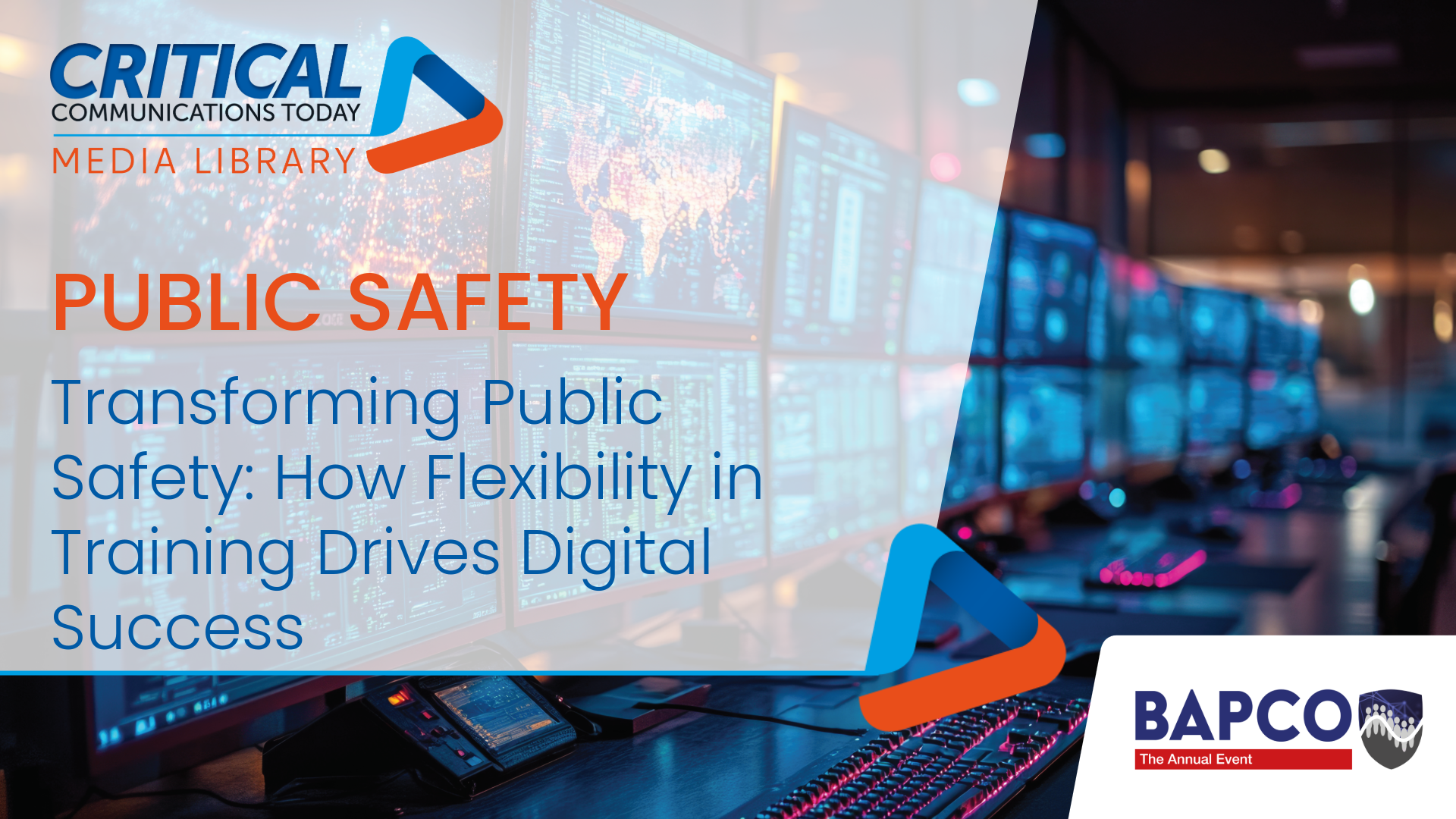I'd like to uh welcome Gillian Fyfe, uh, Gillian is a strategic digital technology and
cyber lead for the NFCC.
Gillian is a passionate and experienced digital transformation professional worker with local
and national government, public sector, third sector, and academia and industry.
She's directed and delivered projects and publications, many of which are leading edge,
um, using digital solutions to improve outcomes for groups as diverse as those with dementia
diagnosis, um, to social enterprise businesses.
Uh, now working with the NFCC, she, uh, she is supporting fire and rescue sector to innovate
and harness technology, adding value and building resilience.
So if we could just welcome, uh, Gillian to the stage, please.
OK. Do you want me to stay in place.
slow So Thank you. That was quite the introduction,
wasn't it? So I hope I can actually live up to it in my,
in my talk. Um, I also have the choice of either being able
to read my notes or see you in the audience, so please don't be offended that I'm going to make
the choice to read my notes. So.
So this afternoon, I was asked to talk a bit about um the challenges of scaling innovation
and fire and rescue. And I'm not sure which direction to point this
in, but it doesn't seem to be moving on.
But I'll just talk anyway.
So we've got a few things, so, so none of these will probably come as a surprise to you,
um, the first one being resistance to change.
So innovation, um, you need to take a whole systems approach to innovation.
You can't just drop something on someone and expect it to work.
Um, we need to understand that the, the people in the process have to come first in any
innovation. And we need to understand any unintended
impacts that we're going to have as a result of anything there.
So using service design principles to to take that full approach.
And unless you have an unusually altruistic workforce, um,
then there has to be something in it for everybody.
You can't just do change for change's sake.
The next thing that is a challenge, particularly in the fire and rescue services
governance models.
So you may or may not be aware that there are about 7 different governance models across fire
and rescue. Some services are part of police and fire crime
commissions, some are combined fire authorities. Some are part of a local authority,
so that a department like social worker education.
So there's no one size fits all approach to any of this work,
and what that means is that the services who are involved,
despite their will and their ambition to change, might have limited control over the systems
that they're working within, so that can affect the way that change can happen and the speed
that innovation can happen.
We also have to think that we have our devolved governments, so NFCC works across the entire UK.
So we have Scotland, we have Wales, we have Northern Ireland,
and any solutions that we are developing centrally have to be fit for purpose for those
services as well. So we tend to work on things that we can deploy
nationally, but with the ability to to tweak locally to fit those governance models.
The next one that I want to talk about is is capability.
So not all our personnel might be trained or equipped to operate and maintain new
technologies, and we have to take the time to embed those in my colleagues they're just
speaking about, you know, kind of putting new pieces of equipment into the service.
That doesn't just happen and work straight away. You have to put time aside for training.
You have to put time aside for understanding.
And none of it should actually come as a surprise to anybody because they should have
been involved in that design process right from the start of this work,
and that helps to overcome some of that resistance.
But if you imagine, you know, you join Fire and Rescue Service as a firefighter,
you didn't necessarily join to be part of someone operating,
um, you know, software platforms, excuse me, I just put this down.
That's not, that wasn't your primary motivation. So all of a sudden you're having to do these
things, you're having to work with these systems, and it's not what you signed up to do.
So we have to make sure that people are given the right time,
the right opportunities, and the right support to be able to put these things in place.
I'm going to talk briefly about budgetary constraints because I think,
you know, none of us have ever operated in an environment, regardless of the sector,
whether it's public, private, third sector, where we've said,
that's brilliant. I've got exactly the right budget I need to do
to be able to do my work, you know, I've got everything that I need.
There are always going to be constraints.
I think so we can use that to our advantage, so it can be something that promotes thinking
differently. So we know that there will never be the ideal
landscape, but it also feeds into one of my my opportunities for change is that necessity is
often the mother of invention.
So having the opportunity to think differently about how we do things can be a valuable
approach to take. And the final challenge that I wanted to talk
about today is risk appetite.
So despite the fact that fire and rescue services dealing risk every day,
they are quite often risk averse in their approach to new technologies and innovation.
And there's a good reason for that because it is, as we've talked about,
you know, kind of today about public safety.
So nobody wants to make a change that has an unintended consequence and you actually break
something really important.
So time has to be given to the thought of how you deal with these security assessments have
to be done. The proper and Review of all the processes that
are going to be affected by implementing any change have to be considered,
and that takes time so innovation doesn't always happen quite as quickly as we might like
it to. However, that being said, um, we have some
opportunities and still not working, so if, if you could move on to the next slide,
that'd be great, thanks.
Um, and we have talent and commitment in buckets in the sector,
so. Yeah, that's when I'm pressing.
Um, we have lots of people now, we're never going to be able to pay um private sector wages.
We're not going to be able to compete with the big tech companies for the talent within our
sector, but that means that we have a lot of people who are really driven by the mission.
So they are there because they want to be there because they want to make the community safer
because they want to do something valuable, so they're driven by more than just just the wage.
Thank you. And we, we have to make the most of that.
So we have to be able to understand the talent that exists within our sector,
and we have to be able to use that as a driver to push things forward.
And that brings connections.
So big part of the work that we do with NFCC is to try and work centrally to to solve problems
for the sector where things that can be solved once in the middle and then can be adopted
locally. So we work a lot to try and bring people out of
their own services to to raise their eyes to look at what's going on elsewhere in other
sectors. We've got, for example, we have networks of all
our IT managers of all our cyber leads, of all our data analysts,
and we bring these people together on a regular basis and we talk about the things that are
really important to the sector.
So that might be a procurement of newA systems. It might be how we're going to look at using
generative AI.
Um, it might be about how we look at um the use of AI and learning and development and
materials and for our stances on that from a from a central point of view.
Productivity and efficiency. We've talked about before,
everybody's trying to do more with less.
But again, that can help us have a new way of talking about things.
So it can give us a different lens to look at things through.
So the way that we've always done things is not necessarily the way that we need to continue to
do things. So it's good to take a step back,
and it's good to look at what other sectors are doing and to understand how we might be able to
solve problems differently within that that governance models that we operate in.
And part of that is our commercial partnerships.
Traditionally, fire and rescue services haven't necessarily been the best customers in a
commercial sense, and I can see some people smiling in the audience even without my glasses
on. Um, so there are about, you know, 50 different
doors to knock on if you're trying to develop a new product for the sector.
Um, so we, we signed a memorandum of understanding with Tech UK in an effort to try
and improve that. We are bringing together the fire and rescue
services with commercial partners on a quarterly basis.
We have a fire innovation for them, and that's really driving the opportunities to have those
conversations outside of any procurement processes.
So we have looked at things like um our next one coming up is the use of drones.
We have looked at data standardisation. We have looked at cybersecurity.
Um, and we have looked at artificial intelligence so far.
So these have been themed conversations, and they're open to any of their tech UK members to
come along and get involved in those.
And what happens is we usually have representatives from the fire and rescue
services there. We'll start the discussion with a bit of an
illustration of some of the things that are going on within services,
and then we can talk about some of the potential solutions that may exist with our
commercial partners and things that they're doing in other sectors and where we might learn
from example from them.
And all of this should be done using user centred design principles.
I mentioned service design before, so we need to make sure that we bring all our stakeholders
together at the earliest opportunity that we don't just surprise them with things at the end
of the thing, the process and say, here you go. Here's a new thing,
go and start using it. You should be involved right from the start in
those early conversations about understanding what is the problem that you're trying to solve,
um, and you'll be surprised if you bring other people into the room and have those discussions,
you would be, you'll be really surprised at the depth of knowledge and the passion that they
have for making things better.
And finally, I just wanted to to finish with some of the things that we think might be
important in the next few years, some of the things that will bring opportunities.
So we will take sensors and allowing us to understand more about what's happening for
firefighters on the ground when they're on the fire ground when they're dealing with incidents.
Artificial intelligence, you know, had to see it.
It's got to be said in everybody's presentation and no,
it doesn't it that's that that's the rules.
Um, but how are we actually going to use it in reality and what's the difference between real
artificial intelligence, perhaps looking at fire specific LLMs and the things that we
sometimes talk about as artificial intelligence when what we really mean is machine learning
and things that have been around um for quite some time.
We're doing a lot of work just now around standardising data and improving the quality of
data, so that is going to lead us to having those foundations to work from,
um, and to to be able to collect that in a much more standardised way,
um, and my colleague Steve Taylor, who some of you, you may have met,
is a, is our data lead in the team, um, very envious of your team of 100.
We have a team of 3, so we have, we have a lot of work to do,
um, but he would have loved the keynote presentation this morning about the
relationship between music and data as well.
Um, drones are getting smarter. The capabilities that are offering us and for
their aerial submarine on the ground, and the work that we can do that will help us not to
put people at risk, um, I think is, is going to be really important.
And the last thing, you know, that that connectivity with a 5G and later 6G and smart
cities and the understanding that we can have of our built environment and how that affects
how we respond to instances and I think it's going to be significant.
um. Although there's one thing that I didn't put on
the list which I think is the thing that scares me and that is the,
the, the post quantum world um and how we deal with um the all our encryption being broken
so that's one that I think we need to be considering now um and how we make sure that we
harden all our systems against that.
Um, and that we're aware of the, the kind of data that might be harvested now to be
decrypted later when the technology exists. So I think we have opportunities to make sure
that we do not, don't fall victim to that now.
And just finally, um, if you're interested in what we're doing,
um, and you would like to, um, to hear more about it,
you can join our mailing list, um, and that'll keep you up to date with any events,
um, that we have going on. Thank you very much.
Thank you very much, Julian, that was uh very interesting.
I'm sure everybody else uh found that as well.
um and uh looking forward to asking some questions later.
Spotlight Fire - Scaling innovation in the fire and rescue sector: challenges and opportunities
4 May 2025
Gillian Fyfe, Strategic Digital, Technology & Cyber Lead - National Fire Chiefs Council (NFCC), delivers this presentation at the BAPCO Annual Event 2025.
Register now to continue watching
We hope you are enjoying the Critical Communications Today Media Library. To continue watching expert-led sessions on key industry topics, please click here to create an account.
The BAPCO Annual Event is the UK's leading public safety event. It is your gateway to discovering the latest advancements, networking with industry experts, and exploring cutting-edge technologies that are transforming the way we ensure public safety.




